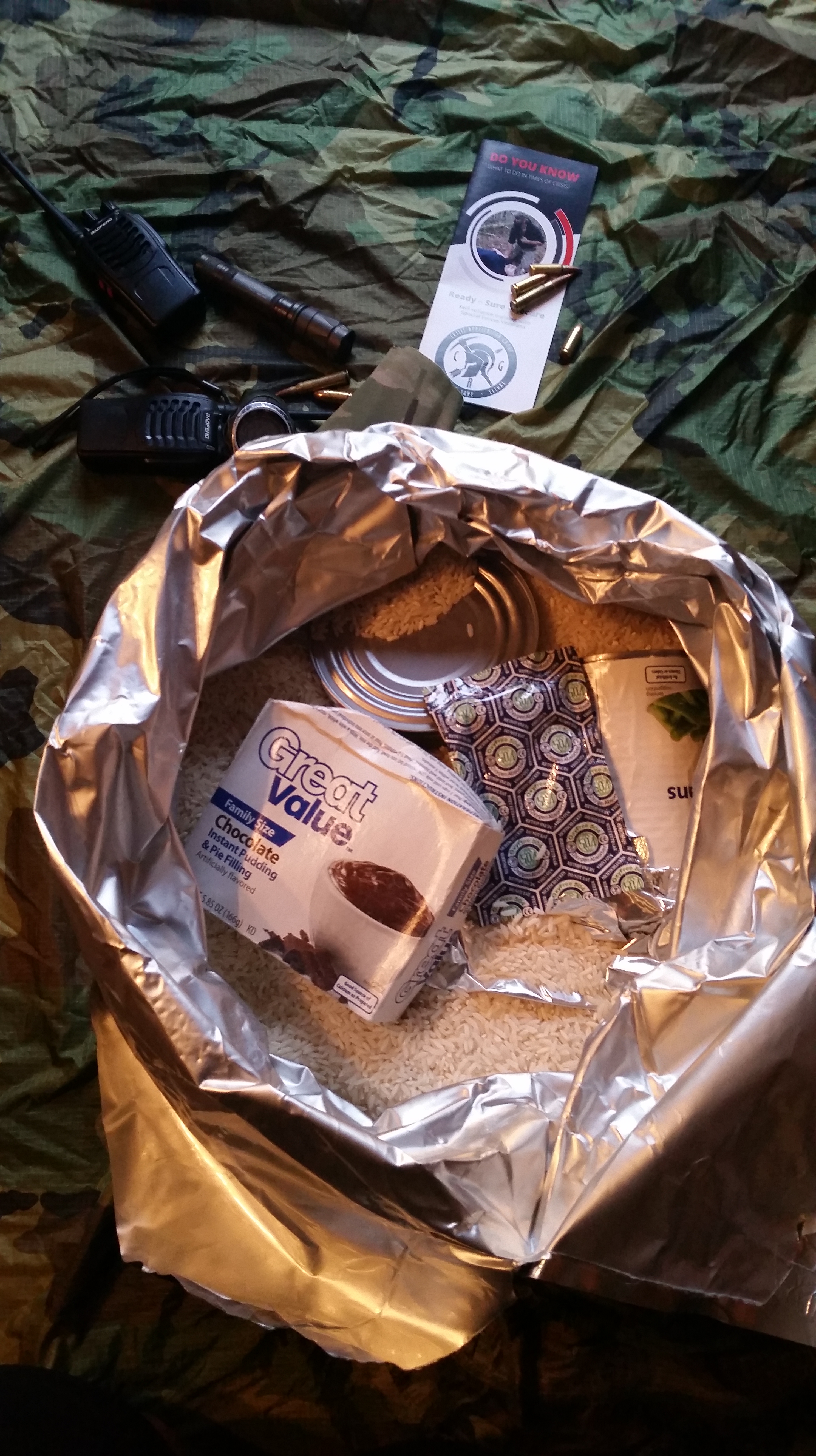A friend was asking me how I store food for the long-term the other day. This prompted me to dissect one of the buckets we normally rotate through and share it with you. When I first started making these buckets of food, all the info I read seemed to be oriented towards 5 gallon buckets of single contents such as rice, beans and such. Thinking from a bug out perspective (I was living in a subdivision near Ft. Bragg, NC at the time), I decided to blaze my own trail as usual.
I didn’t want to grab a bucket in a rush and end up eating white rice everyday. So I started making variety buckets. The idea was to use the rice as filler like packing peanuts. I was a little concerned with having canned food amongst all the rice but it was a calculated risk. I figured with the bucket filled, no dead space and an oxygen absorber, there would be little chance of rust or oxidization. At first it was sort of random and then there were “themed” buckets…Italian, Mexican and so on. Some diversity goes a long way when it comes to grub and morale. So I got creative.
I started with $3 bucket and lids from Wally world. Ordered some mylar bags and oxygen absorbers of the interweb and went shopping. I’m frugal so we would go to Save-A-Lot, Big Lots and look for sales. We started buying a few more of this and that. The instant type side dishes seemed like a perfect addition. we would disassemble the original packaging and vacuum seal the contents, then date and label it. Potatoes au gratin, Mac-n-cheese, Stovetop Stuffing, Hamburger Helper, spice packages to complement the other contents. Throw in some legumes, drink mix, hard candy and bullion cubes and you have a bucket that’s around 40lbs with at least a weeks forth of food for a family of 4.
Once we got going, we started vacuum sealing the canned food just in case the metal can deteriorated. This was to prevent it from spoiling the other contents. Turns out it wasn’t really necessary. We placed the mylar in the bucket, put down a paper plate and a layer of rice. The intent was to prevent any the hard edges of the cans from puncturing the mylar if they managed to settle to the bottom. Then we just added the vacuum sealed side dishes and other contents and poured rice around it as we filled it up. Once the bucket was full, I used clothes iron to seal the mylar nearly all the way. We left it open just enough to get the O2 absorber in and then sealed it around the hose from the vacuum sealer. Once it was devoid of air, we would take the iron and finish sealing, then pulled out the vacuum hose. We placed 3×5 cards with the contents on top and put the lid on. You could also attach it to the outside for quick reference.
This particular bucket was packed in December of 2008. It’s nearly 7 years old. As you can see in the photos, everything is just as it went in. The rice doesn’t have any off odors that old rice left out usually gets after a while. The canned goods have no rust, swelling or discoloration. All our buckets sit in a non-climate controlled workshop. So there was no special treatment, they are just how they would be with no electricity.
The contents of this bucket are as follows:
15 lbs rice
4 lbs of dry beans
1lb of lentils
2 cans of chicken
1 each cans of corn, green beans, diced tomatoes, tomato paste, fruit cocktail and evaporated milk
1 box of Stovetop stuffing
1 vacuum sealed bag of instant potatoes (2 cups from a big box)
20 bullion cubes
1 pkg Spaghetti sauce mix
2 pkg Italian seasoning
1 lb macaroni elbows in mylar
10 individual pkg instant Kool-Aid
1 pkg chocolate pudding
To put some of this into perspective, there are 34 one cup servings (cooked) of rice, 24 one cup servings (cooked) of beans, 6 servings of stuffing, about 8 servings of mash potatoes, and 16 servings of pasta. When you start mixing and creating different meals it spreads out even further. Add some corn to the rice, add some wild game to the beans. Make a rice pudding and add some chocolate pudding mix.
In my opinion, long-term food storage shouldn’t be about buying a bunch of food you don’t normally eat and putting it away for 20 years. The key to successful long term food storage is to rotate stock and actually live off it now. This 5 gallon bucket will get turned into meals and eaten by my family over the next week or so and a new one will take its place in the shop.
There are a lot of ways to store food. This is just one idea that seemed to make sense to me and it works. These buckets are good for camping, when store shelves are empty and for if you fall on hard times and get laid off work. if you need to bug out in a hurry, throw 2 in the trunk. Get creative. Keep your kids in mind as well. Jolly Ranchers will make a kids day if you really have to use your food stores.
*The views and opinions expressed on this website are solely those of the original authors and contributors. These views and opinions do not necessarily represent those of Spotter Up Magazine, the administrative staff, and/or any/all contributors to this site.
All content from this article courtesy of our friend Jay Paisley (18z) ret. 5th Special Forces Group
*The views and opinions expressed on this website are solely those of the original authors and contributors. These views and opinions do not necessarily represent those of Spotter Up Magazine, the administrative staff, and/or any/all contributors to this site.



